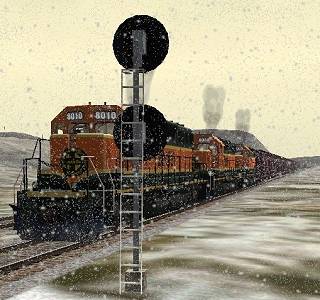
Home
msts-trains StationTweaks
Camera AnglesA New Headout View
Equipment & Scenery
SP Alco S4 #1474New Rail 1
Real Falling Snow
City Track
Utility
Transparent Driver AidsKeyboard Template
Miscellaneous
Favorite ScreenshotsLinks

real falling snow
Default MSTS falling snow is blobby and sparse, and doesn't look much like falling snow to me. The default .ENV settings also set the drop speed so it falls way too fast, like rain. In fact, it is set to the same drop speed value as rain, which makes no sense to me at all. The snow also isn't nearly dense enough to accurately represent real falling snow. Real Falling Snow for MSTS attempts to correct these problems, giving you a realistic falling and blowing snow. Now, finally drive through real falling snow on your route. This is my version of MSTS snow, and is available on the train-sim.com site. Search for the files rfsnow.zip (day snow) and ntsnow.zip (night snow). If you use the Environmental Control program by Jeff Bush, Real Falling Snow has been bundled to work with it. In this case, see file ecrfsnow.zip
Real Falling Snow

Why Different Textures for Night Snow?
Lighter colored snow as used for daytime scenes becomes blinding at night, masking the scenery which is already dark. Night Snow snow textures cure this problem for driving in snow at night. They are much darker and visibility is much improved. Continue to use the lighter snow textures for daytime driving, as they improve the visibility of the snow itself against white backgrounds.
Notes and Findings About MSTS Snow
Snow flakes are more like pinpoints of white or gray, and can be represented that way in a graphic image. In fact a medium gray color is better than pure white, as the small pinpoint flakes can then be seen against a white wintery background, which enhances the overall effect. The difference in color from pure white is hardy noticed.
MSTS generally uses itty-bitty graphics (sized at 128x128) for sky, rain, snow, and stars texture. This may lighten the load on the processor somewhat, but it greatly reduces the true-to-life portrayal of these effects. Generally, I have found that environmental graphics (sky, rain, snow, stars, etc.) look much better the bigger they are, and usually a size of 512x512 is optimum for accuracy in detail. MSTS insists on using 128x128 sized graphics in most cases and they are stretched to the limit. This is partly the reason why snow and the night time stars look like blobs instead of pinpoints. Resizing the snow graphic is desirable, however a 512x512 graphic greatly taxes the processor and frame rate and effects the overall smoothness of the snow effect. Thus a compromise was reached and the snow graphic was resized to 256x256. Resizing the basic snow graphic to 256x256 will also reduce the stretching when MSTS creates the falling texture tiles, and reduce the further blobbing effect of the snow flakes.
Snow layer density is increased in two ways. In the snow.env file, the precipitation density has been doubled from 4096 to 8192, as such:
world_precipitation_density ( 8192 )
Snow flake density is also increased simply by adding more gray dots to the texture image.
Snow falling speed has been reduced from 15 to 6, a compromised value, as such:
world_precipitation_speed ( 6 )
A speed of 1 or 2 is really more realistic for falling snow, however area coverage and apparent density falls short below a value of about 5.
